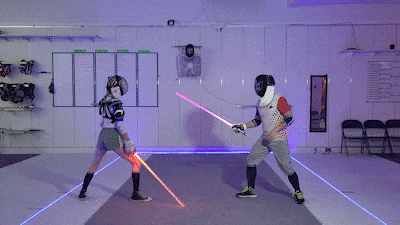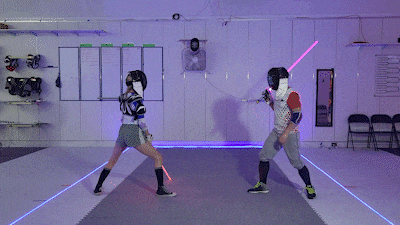You can be very safe and very successful by knowing just these two basic attacks. And don’t let the term “basic” fool you; these are used by Lightspeed Saber fencers of every level, including the top athletes.
THE STRAIGHT CUT
The Straight Cut is the first attack that every Lightspeed Saber beginner should learn. This is an unchambered, percussive attack, and consists of two combined actions: 1) an arm extension, and 2) a percussion (wrist pitch).
The Straight Cut is fast and safe.
To perform the Straight cut
Begin in Makashi Guard: blade leaned forward, tip placed between eye and chest height.
Without moving your wrist, extend your arm.
Percuss the surface of the target:
Pitch your wrist forward so the blade arcs toward the target surface.
As the blade is making contact with the surface of the target, swiftly pitch back to return the blade to its original position.
You should touch the target exactly once, without any bouncing, sliding, skipping, bending, etc.
Return to Makashi Guard.
COMMON MISTAKES
Inefficient attacks. These attack variations take longer to complete, and have unnecessarily elevated power potential. Start from Makashi Guard. Always extend & pitch.
Dangerous tip control. Leaving the tip at extension after the cut is called holding and is unsafe and illegal. Always retract the weapon after the cut.
Excessive force. Attack accelerates beyond the target needlessly. Aim for and retract at the surface of the target, ie the top of the glove or mask.
THE LATERAL CUT
This is just a variation of the Straight Cut meant to cut sideways instead of vertically. This requires a simple turn of the wrist, but, if done poorly, can result in an unnecessary chamber.
Like the Straight Cut, this is an unchambered, percussive attack, but uses three combined actions: 1) a wrist roll, 2) an arm extension, and 3) a sideway percussion (sideways wrist pitch).
To perform a lateral cut
Begin in Makashi Guard: blade leaned forward, tip placed between eye and chest height.
Roll your wrist right or left.
Extend your arm.
Percuss the surface of the target.
Return to Makashi Guard.
COMMON MISTAKES
Inefficient attacks. These attack variations take longer to complete, and have unnecessarily elevated power potential. Start from Makashi Guard. Always lead with the blade, not the hand.
Excessive force. Attacks accelerate beyond the target needlessly. Aim for and retract at the surface of the target, ie the sides of the glove or mask.
Dangerous tip control. Leaving the tip at extension after the cut is called holding and is unsafe and illegal. Always percuss the target.
TIMID FENCERS!
Are you afraid of hurting someone? Is this holding you back? You’re exactly the kind of person we want here, because we trust you to be safe. Now let’s make you successful.
iS IT POSSIBLE TO HIT TOO SOFTLY?
Yes. If you are hitting so softly that the referees cannot detect it, then you are fencing poorly, when our goal is for you to be safe and successful.
how hard is hard enough?
You want to use enough force to generate a sound, just loud enough for your opponent, your referee, and yourself to hear. If you could barely hear it, then you’ll be lucky if the refs could. That said, you don’t need the whole room to hear it!
What if I’m still unsure?
You’re encouraged to check after the welfare of your opponent or sparring partner periodically to make sure they are comfortable. This is entirely normal and good etiquette.
If you think you have committed a force error, you can always decline any points awarded.
While not as clean and clear as the demonstrations (real life never is), these Straight and Lateral Cuts are fast, audible, and considered fair play.






